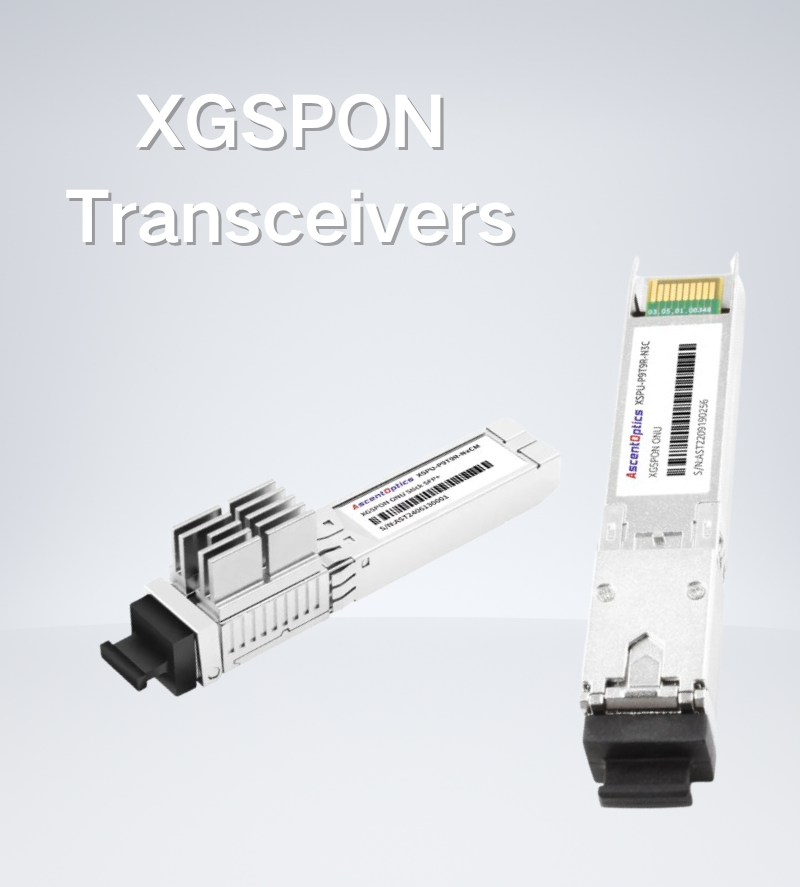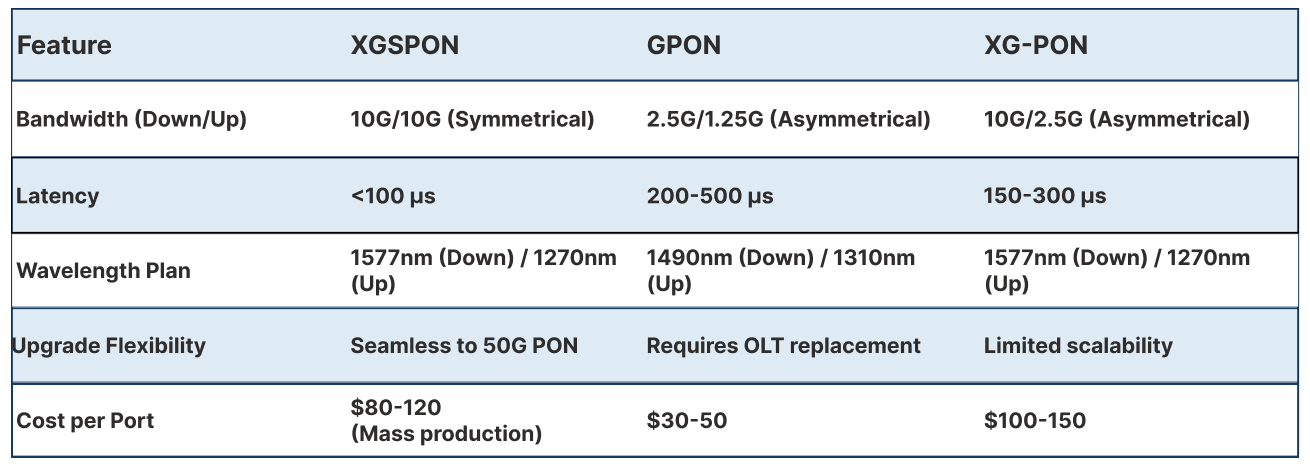Amid the digital transformation wave, emerging applications like 8K ultra-HD video, Industrial IoT (IIoT), and 5G backhaul demand unprecedented network bandwidth and real-time performance. Traditional asymmetric PON technologies (e.g., GPON/XGPON), with their limited uplink bandwidth (only 2.5Gbps), now struggle to support high-interaction services such as enterprise cloud migration and telemedicine. In this context, XGSPON (10G Symmetrical Passive Optical Network) has emerged as a core technology for fiber access networks to evolve into the gigabit era.
It achieves this by offering symmetrical 10Gbps transmission speeds for both upstream and downstream traffic. The implementation of this technology relies on a critical hardware component: XGSPON optical modules.
Acting as “translators” for optical signals, these modules enable ultra-wide bandwidth and low-latency communication channels between OLT (Optical Line Terminal) and ONU (Optical Network Unit). They do this through efficient photoelectric conversion and wavelength management. Serving as an “invisible cornerstone,” XGSPON optical modules are essential for upgrading infrastructure—whether for telecom operators, enterprises, or smart cities.

XGSPON (10G-EPON), an advanced Passive Optical Network (PON) technology, has become the ideal choice for modern fiber-optic access networks due to its key features including high bandwidth, low latency, long-distance transmission, compatibility, cost-effectiveness, high reliability, and security. It not only addresses current high-bandwidth demands but also lays a robust foundation for future network evolution.
XGSPON (10G Symmetric Passive Optical Network) is an Ethernet-based passive optical network (PON) technology that delivers 10Gbps symmetric bandwidth. As an enhanced version of EPON (Ethernet PON), it is designed to meet the demands of high-bandwidth application scenarios.
By leveraging wavelength-division multiplexing (WDM) technology, XGSPON enables simultaneous upstream and downstream signal transmission over a single optical fiber, achieving high-bandwidth and low-latency network services.
The XGSPON optical module employs an EML (Electro-absorption Modulated Laser) transmitter and APD (Avalanche Photodiode) receiver to achieve 10Gbps symmetric transmission at wavelengths of 1270nm (upstream) and 1577nm (downstream). With an optical power range of +2 to +7 dBm (transmitter) and a receiver sensitivity of -28 dBm, it supports transmission distances exceeding 20 kilometers.
Additionally, its industrial-grade packaging (-40°C to 85°C) ensures reliable operation in harsh environmental conditions.

Symmetric Bandwidth: XGSPON delivers 10 Gbps bidirectional bandwidth (10 Gbps upstream/downstream), addressing high-demand scenarios such as 4K/8K video streaming, cloud gaming, and enterprise-grade telecommuting (requiring 500+ Mbps per user).
Asymmetric Mode Support: Also compatible with 10 Gbps downstream + 2.5 Gbps upstream configurations, optimized for cost-sensitive deployments like residential broadband and SME networks (typical usage: 80% downstream traffic dominance).
Advanced Signal Processing: XGSPON achieves ultra-low transmission latency through cutting-edge signal processing technologies, making it ideal for real-time applications like online gamingand video conferencing.
Real-Time Responsiveness: This low-latency performance ensures instantaneous data transfer, significantly enhancing user experience.
Maximum Transmission Distance: XGSPON supports up to 20-kilometer reach, enabling wide-area coverage, particularly in rural and remote areas.
Signal Stability: Combines high-quality fiber with optimized optical modules to ensure superior signal integrity and reliability over long distances.
GPON Compatibility: XGSPON is backward-compatible with existing GPON networks, enabling seamless upgrades and protecting operators’ infrastructure investments.
Multi-Vendor Support: XGSPON devices are offered by multiple vendors, ensuring market diversity and cross-network interoperability.
Leverage Existing Infrastructure: XGSPON reuses existing fiber infrastructure, slashing network deployment and maintenance costs.
Economies of Scale: With widespread adoption, XGSPON equipment costs continue to drop, boosting its cost-effectiveness.
Multi-Scenario Support: XGSPON adapts to various scenarios, including FTTH(Fiber to the Home), FTTB(Fiber to the Building), and FTTO(Fiber to the Office).
Dynamic Bandwidth Allocation (DBA): Automatically adjusts bandwidth based on real-time user needs, maximizing network efficiency.
Future-Proof Upgrades: XGSPON is highly scalable, supporting seamless upgrades to higher-speed PON technologies like 25G PON and 50G PON.
Network Evolution: Enables stepwise network evolution, protecting operators’ long-term investments.
XGSPON (10G Symmetrical PON) is widely deployed in the following scenarios:
Live Streaming & Video Surveillance: XGSPON’s symmetrical 10Gbps bandwidth (9.953 Gbps upstream/downstream) addresses the high uplink demands of multi-camera live streamingand 4K/8K surveillance systems.
Enterprise Dedicated Lines: Delivers symmetrical, carrier-grade connectivity for businesses requiring stable, high-speed dedicated lines (e.g., cloud services, data center interconnects).

Residential Gateway: The XGSPON ONU Stick replaces traditional optical modems for home broadband access, supporting HD video streaming, online gaming, and other high-bandwidth applications.
High-Density Housing: In densely populated high-rise buildings, XGSPON’s high-density access capability optimizes OLT port usage and fiber resource efficiency.
Mobile Base Station Backhaul: XGSPON’s low latency (<100μs) and high bandwidth make it ideal for 5G fronthaul/midhaul, offering a cost-effective fiber backhaul solution for dense small cell deployments.
RAN Architecture:Supports CPRI/eCPRI protocolsto meet strict latency and synchronization requirements in centralized radio access networks.
Data Center Interconnect (DCI): The XGSPON Stick plugs into SFP+ ports on switches/routers (e.g., Ubiquiti, Mikrotik devices), enabling direct PON network access. This plug-and-play design simplifies data center architectures while reducing cabling costs.

XGS-PON and XG-PON both belong to GPON series. XGS-PON is the technological evolution of GPON and XG-PON, supporting the mixed access of GPON, XG-PON and XGS-PON ONU.
XG-PON and XGS-PON are both 10G PON. The main difference is that XG-PON is an asymmetric PON, and the uplink/downlink rate of the PON port is 2.5G/10G; XGS-PON is a symmetric PON, and the uplink/downlink rate of the PON port is 10G/10G.
Since the uplink/downlink wavelengths are different from GPON, XGS-PON uses the Combo solutions to share ODN with GPON.

AscentOptics can provide XG-SPON OLT SFP+and XFP transceivers (N1, N2 and E1 according to ODN Class) for XGSPON OLT devices and XGSPON&GPON Combo OLT SFP+ transceivers (B+/N1, C+/N2, B+/D1, C+/D2 according to ODN Class) that support mixed access of GPON, XG-PON and XGS-PON ONUs. We can also provide XGSPON ONU SFP+ transceivers for XGSPON ONU devices.
As the defining decade for fiber access to evolve from gigabit to 10G capabilities, the large-scale commercialization of XGSPON optical modules not only delivers a cost-effective solutionfor current 5G and fixed-network convergence, but also reserves technical pathways for smooth evolution to 50G PON through wavelength planning and hardware compatibility (e.g., tunable lasers supporting NG-PON2 standards).
Looking ahead, XGSPON will continue evolving toward higher bandwidth and lower costs. By maintaining backward compatibility and coexistence with existing PON technologies, it ensures seamless network transitionsand future-proof upgrades. Simultaneously, the ongoing refinement of international (ITU-T) and domestic standards will solidify its technical foundation and regulatory framework, driving global adoption across telecom and enterprise markets.